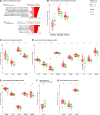Metformin boosts antitumor immunity and improves prognosis in upfront resected pancreatic cancer: an observational study
- PMID: 38530777
- PMCID: PMC11308183
- DOI: 10.1093/jnci/djae070
Metformin boosts antitumor immunity and improves prognosis in upfront resected pancreatic cancer: an observational study
Abstract
Background: Beyond demographic and immune factors, metabolic considerations, particularly metformin's recognized impact in oncology, warrant exploration in treating pancreatic cancer. This study aimed to investigate the influence of metformin on patient survival and its potential correlation with distinct immune profiles in pancreatic ductal adenocarcinoma (PDAC) tumors.
Methods: We included 82 upfront resected and 66 gemcitabine-based neoadjuvant chemoradiotherapy (nCRT)-treated patients from the PREOPANC randomized controlled trial (RCT). Transcriptomic NanoString immunoprofiling was performed for a subset of 96 available resected specimens.
Results: Disparities in survival outcomes and immune profiles were apparent between metformin and non-metformin users in upfront resected patients but lacking in nCRT-treated patients. Compared to non-metformin users, upfront resected metformin users showed a higher median overall survival (OS) of 29 vs 14 months and a better 5-year OS rate of 19% vs 5%. Furthermore, metformin use was a favorable prognostic factor for OS in the upfront surgery group (HR = 0.56; 95% CI = 0.32 to 0.99). Transcriptomic data revealed that metformin users significantly underexpressed genes related to pro-tumoral immunity, including monocyte to M2 macrophage polarization and activation. Furthermore, the relative abundance of anti-inflammatory CD163+ MRC1+ M2 macrophages in non-metformin users and immune-activating CD1A+ CD1C+ dendritic cells in metformin users was heightened (P < .001).
Conclusion: This study unveils immune profile changes resulting from metformin use in upfront resected pancreatic cancer patients, possibly contributing to prolonged survival outcomes. Specifically, metformin use may decrease the abundance and activity of pro-tumoral M2 macrophages and increase the recruitment and function of tumor-resolving DCs, favoring antitumor immunity.[PREOPANC trial EudraCT: 2012-003181-40].
© The Author(s) 2024. Published by Oxford University Press.
Conflict of interest statement
The authors declare that they have no competing interests.
Figures



References
-
- Malvezzi M, Santucci C, Boffetta P, et al.European cancer mortality predictions for the year 2023 with focus on lung cancer. Ann Oncol. 2023;34(4):410-419. - PubMed
-
- Siegel RL, Miller KD, Wagle NS, et al.Cancer statistics, 2023. CA Cancer J Clin. 2023;73(1):17-48. - PubMed
-
- Winter JM, Brennan MF, Tang LH, et al.Survival after resection of pancreatic adenocarcinoma: Results from a single institution over three decades. Ann Surg Oncol. 2012;19(1):169-175. - PubMed
-
- Paniccia A, Hosokawa P, Henderson W, et al.Characteristics of 10-year survivors of pancreatic ductal adenocarcinoma. JAMA Surg. 2015;150(8):701-710. - PubMed
Publication types
MeSH terms
Substances
Grants and funding
LinkOut - more resources
Full Text Sources
Medical
Research Materials
Miscellaneous

